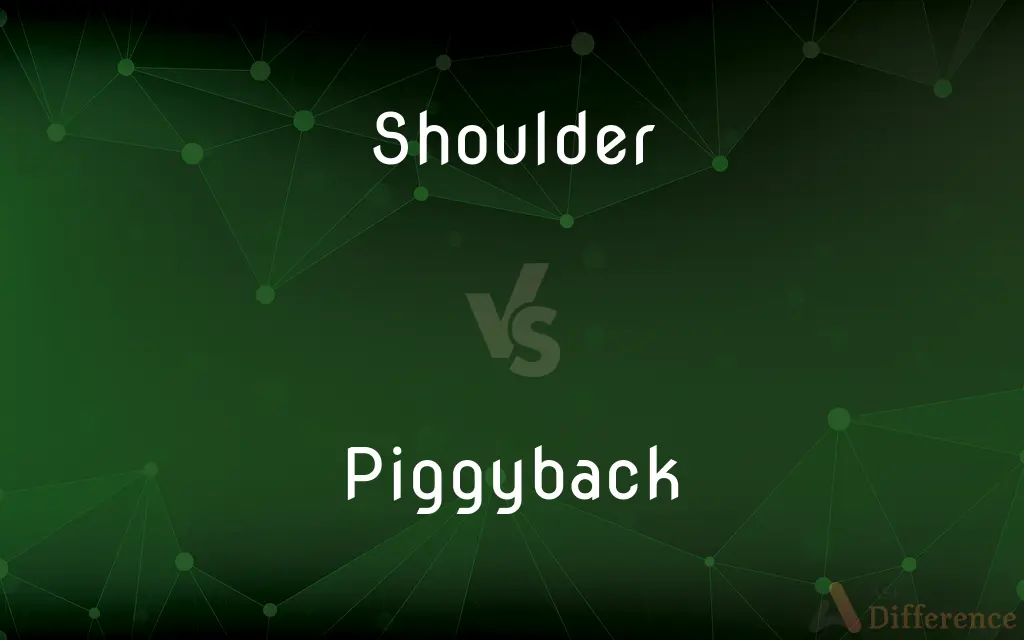Shoulder vs. Piggyback — What's the Difference?
Edited by Tayyaba Rehman — By Urooj Arif — Updated on April 5, 2024
Shoulder refers to the part of the body connecting the arm to the torso, while piggyback denotes carrying someone on one's back and shoulders.

Difference Between Shoulder and Piggyback
Table of Contents
ADVERTISEMENT
Key Differences
The shoulder is an anatomical region that includes the joint connecting the arm to the torso, allowing for a wide range of arm movements. It is crucial for many activities, from lifting objects to throwing a ball. On the other hand, piggyback describes a method of carrying, usually a person, on one's back with the arms wrapped around the carrier's shoulders. This form of transport is often used playfully with children or in situations requiring one person to carry another.
Shoulders are made up of several key structures, including bones, muscles, and tendons, which work together to provide strength and flexibility. The health and functionality of a person's shoulders are vital for daily activities and professional tasks, especially those requiring physical exertion. Conversely, piggyback rides, while they can involve the shoulders as a support base, are a temporary, interactive action primarily for convenience or enjoyment, rather than an anatomical feature or a permanent state.
In discussing physical health and anatomy, the shoulder's condition, such as muscle strength and joint mobility, is often a focus of medical and fitness professionals. It's essential for overall physical health and the ability to perform tasks. Piggyback, while not directly related to health in the same way, requires physical strength and balance, particularly in the shoulders and back, to safely carry another person without causing injury to either party.
Culturally, shoulders represent strength, responsibility, and the burden one can carry, both literally and figuratively. They are often mentioned in expressions about bearing weight or responsibility. Piggyback rides, however, are associated with carefree moments, childhood, and bonding between parents and children or between friends, symbolizing support and trust in a more literal sense.
While both terms involve the concept of support, shoulders signify physical and metaphorical support intrinsic to one's body and character. In contrast, piggyback rides represent a temporary and often playful form of support, where one person physically carries another, emphasizing mutual trust and cooperation.
ADVERTISEMENT
Comparison Chart
Definition
The anatomical region connecting the arm to the torso.
Carrying someone on one's back and shoulders.
Composition
Bones, muscles, tendons.
An action involving two people.
Primary Function
Provide support and movement for the arm.
To transport or carry someone playfully or out of necessity.
Health Relevance
Subject to injuries and disorders; focus of medical care.
Involves physical effort and balance; can indicate trust.
Cultural Symbolism
Represents strength, burden-bearing.
Symbolizes care, fun, or assistance.
Compare with Definitions
Shoulder
Anatomical joint connecting arm to torso.
He injured his shoulder during the game.
Piggyback
Symbolizes playful transport.
They enjoyed piggyback races at the picnic.
Shoulder
Pivot for arm movement.
A healthy shoulder allows for a full range of motion.
Piggyback
Requires strength and balance.
Giving piggyback rides can be a fun way to strengthen the back.
Shoulder
Point of attachment for muscles and tendons.
Strengthening the muscles around the shoulder helps prevent injuries.
Piggyback
Can be used for practical purposes.
In emergencies, piggybacking can quickly move someone to safety.
Shoulder
Subject to various injuries.
Rotator cuff tears are common shoulder injuries.
Piggyback
A method of carrying on the back.
The father gave his tired child a piggyback ride home.
Shoulder
Symbol of strength and responsibility.
She carried the burden on her shoulders.
Piggyback
Indicates closeness and trust.
The siblings shared a bond, often seen in their piggyback games.
Shoulder
The human shoulder is made up of three bones: the clavicle (collarbone), the scapula (shoulder blade), and the humerus (upper arm bone) as well as associated muscles, ligaments and tendons. The articulations between the bones of the shoulder make up the shoulder joints.
Piggyback
A ride on someone's back and shoulders
He always gives us a piggyback up the stairs to bed
Shoulder
The upper joint of each of a person's arms and the part of the body between this and the neck
I was carrying a bag over my shoulder
He tapped me on the shoulder and I looked round
She turned to look at him over her shoulder
Piggyback
On the back and shoulders of another person
A piggyback ride
Shoulder
A part of something resembling a shoulder in shape, position, or function
The shoulder of a pulley
Piggyback
On the back and shoulders of another person
I had to carry him piggyback
Shoulder
Another term for hard shoulder
Piggyback
Carry by or as if by means of a piggyback
I'll piggyback you the rest of the way
Shoulder
Put (something heavy) over one's shoulder or shoulders to carry
We shouldered our crippling backpacks and set off slowly up the hill
Piggyback
On the shoulders or back
Ride piggyback.
A piggyback ride.
Shoulder
Push (someone or something) out of one's way with one's shoulder
She shouldered him brusquely aside
Piggyback
By or relating to a method of transportation in which truck trailers are carried on trains, or cars on specially designed trucks.
Shoulder
The joint connecting the arm with the torso.
Piggyback
In connection with something larger or more important
A tariff provision that came piggyback with the tax bill.
A piggyback provision to a new piece of legislation.
Shoulder
The part of the human body between the neck and upper arm.
Piggyback
The act of transporting piggyback.
Shoulder
The joint of a vertebrate animal that connects the forelimb to the trunk.
Piggyback
To cause to be aligned with an issue, for example, that is larger or more important
"a $21.5-million federal grant to piggyback city and state subsidies" (New York).
Shoulder
The part of an animal near this joint.
Piggyback
To function as if carried on the back of another
"This reagent will piggyback onto an enzyme" (Seth Rolbein).
Shoulder
Often shoulders The area of the back from one shoulder to the other.
Piggyback
On somebody's back or shoulders.
Give someone a piggyback ride
Shoulder
A cut of meat including the joint of the foreleg and adjacent parts.
Piggyback
Pertaining to transportation of goods where one transportation unit is carried on the back of something else. For example, a truck on a train.
Shoulder
The portion of a garment that covers the shoulder.
Piggyback
Attached or appended to something larger or more important.
Piggyback legislation
Shoulder
The angle between the face and flank of a bastion in a fortification.
Piggyback
On somebody's back or shoulders.
To ride piggyback
Shoulder
The area between the body and neck of a bottle or vase.
Piggyback
(transitive) To carry (someone) on the back or shoulders.
Shoulder
The end surface of a board from which a tenon projects.
Piggyback
(ambitransitive) To attach or append something to another (usually larger) object or event.
They tried to piggyback that proposal on the rivers and harbors bill.
Shoulder
(Printing) The flat surface on the body of type that extends beyond the letter or character.
Piggyback
To obtain a wireless internet connection by bringing one's own computer within the range of another's wireless connection without that subscriber's permission or knowledge.
Shoulder
The edge or border running on either side of a roadway.
Piggyback
To utilize "last-mile" wiring rented from a larger owner ISP by a smaller ISP.
Shoulder
To carry or place (a burden, for example) on a shoulder or on the shoulders.
Piggyback
(transitive) To transport (a lorry/truck) on a flatbed railway waggon
Shoulder
To take on; assume
Shouldered the blame for his friends.
Piggyback
(transitive) To enter a secured area at the same time along with someone having authorized access; to tailgate
Shoulder
To push or apply force to with a shoulder
Shouldered the dresser against the wall.
Piggyback
(countable) A ride on somebody's back or shoulders.
Shoulder
To make (one's way) by shoving one's shoulders.
Piggyback
An act or instance of piggybacking.
Shoulder
To push with a shoulder.
Piggyback
The connection of one intravenous drip to another.
Shoulder
To make one's way by shoving one's shoulders.
Piggyback
Ride on someone's shoulders or back
Shoulder
The part of an animal's body between the base of the neck and forearm socket.
Piggyback
Haul truck trailers loaded with commodities on railroad cars
Shoulder
The part of the human torso forming a relatively horizontal surface running away from the neck.
The parrot was sitting on Steve's shoulder.
Piggyback
Haul by railroad car
Shoulder
(anatomy) The joint between the arm and the torso, sometimes including the surrounding muscles, tendons, and ligaments.
Piggyback
Carry on the back or shoulders;
She piggybacked a sick classmate to school
Shoulder
A cut of meat comprising the upper joint of the foreleg and the surrounding muscle.
Piggyback
Support on the back and shoulders;
He piggybacked her child so she could see the show
Shoulder
The portion of a garment where the shoulder is clothed.
Piggyback
On a railroad flatcar;
The trailer rode piggyback across the country
Shoulder
Anything forming a shape resembling a human shoulder.
Piggyback
On the back or shoulder or astraddle on the hip;
She carried her child piggyback
Shoulder
(topography) A shelf between two levels.
Shoulder
A usually unsealed strip of land bordering a road, where vehicles can drive or park in an emergency.
He stopped the car on the shoulder of the highway to change the flat tire.
Shoulder
The portion of a hill or mountain just below the peak.
Shoulder
A lateral protrusion of a hill or mountain.
Shoulder
The angle of a bastion included between the face and flank.
Shoulder
An abrupt projection which forms an abutment on an object, or limits motion, etc., such as the projection around a tenon at the end of a piece of timber.
Shoulder
(printing) The flat portion of type that is below the bevelled portion that joins up with the face.
Shoulder
(of an object) The portion between the neck and the body.
Shoulder
(music) The rounded portion of a stringed instrument where the neck joins the body.
Shoulder
The rounded portion of a bottle where the neck meets the body.
Shoulder
(firearms) The angled section between the neck and the main body of a cartridge.
Shoulder
(figurative) That which supports or sustains; support.
Shoulder
The part of a key between the cuts and the bow.Parts of a Yale lock-type key
Shoulder
(surfing) The part of a wave that has not yet broken.
Shoulder
(aviation) A season or a time of day when there is relatively little air traffic.
Noon balloon
Shoulder
(transitive) To push (a person or thing) using one's shoulder.
Shoulder
(transitive) To put (something) on one's shoulders.
Shoulder
(transitive) To place (something) against one's shoulders.
Shoulder
To bear a burden, as a financial obligation.
Shoulder
To accept responsibility for.
Shoulder the blame
Shoulder
(transitive) To form a shape resembling a shoulder.
Shoulder
(intransitive) To move by or as if by using one's shoulders.
Shoulder
(transitive) To round and slightly raise the top edges of slate shingles so that they form a tighter fit at the lower edge and can be swung aside to expose the nail.
Shoulder
(intransitive) To slope downwards from the crest and whitewater portion of a wave.
Shoulder
Of a servant: to embezzle money from (the employer).
Shoulder
The joint, or the region of the joint, by which the fore limb is connected with the body or with the shoulder girdle; the projection formed by the bones and muscles about that joint.
Shoulder
The flesh and muscles connected with the shoulder joint; the upper part of the back; that part of the human frame on which it is most easy to carry a heavy burden; - often used in the plural.
Then by main force pulled up, and on his shoulders boreThe gates of Azza.
Adown her shoulders fell her length of hair.
Shoulder
Fig.: That which supports or sustains; support.
In thy shoulder do I build my seat.
Shoulder
That which resembles a human shoulder, as any protuberance or projection from the body of a thing.
The north western shoulder of the mountain.
Shoulder
The upper joint of the fore leg and adjacent parts of an animal, dressed for market; as, a shoulder of mutton.
Shoulder
The angle of a bastion included between the face and flank. See Illust. of Bastion.
Shoulder
An abrupt projection which forms an abutment on an object, or limits motion, etc., as the projection around a tenon at the end of a piece of timber, the part of the top of a type which projects beyond the base of the raised character, etc.
Shoulder
To push or thrust with the shoulder; to push with violence; to jostle.
As they the earth would shoulder from her seat.
Around her numberless the rabble flowed,Shouldering each other, crowding for a view.
Shoulder
To take upon the shoulder or shoulders; as, to shoulder a basket; hence, to assume the burden or responsibility of; as, to shoulder blame; to shoulder a debt.
As if HerculesOr burly Atlas shouldered up their state.
Shoulder
To push with the shoulder; to make one's way, as through a crowd, by using the shoulders; to move swaying the shoulders from side to side.
A yoke of the great sulky white bullocks . . . came shouldering along together.
Shoulder
The part of the body between the neck and the upper arm
Shoulder
A cut of beef from the shoulder of the animal
Shoulder
A ball-and-socket joint between the head of the humerus and a cavity of the scapula
Shoulder
Narrow edge of land (usually unpaved) along the side of a road
Shoulder
Lift onto one's shoulders
Shoulder
Push with the shoulders;
He shouldered his way into the crowd
Shoulder
Carry a burden, either real or metaphoric;
Shoulder the burden
Common Curiosities
Is piggybacking safe?
Piggybacking can be safe if done carefully, considering the carrier's strength and the weight of the person being carried.
What part of the body is the shoulder?
The shoulder is the region where the arm connects to the torso.
What does piggyback mean?
Piggyback means carrying someone on your back with their arms around your shoulders.
What is the significance of shoulders in physical activities?
Shoulders play a crucial role in various physical activities, providing strength and range of motion.
What are common shoulder injuries?
Common shoulder injuries include dislocations, sprains, and rotator cuff tears.
How does giving a piggyback ride affect the body?
It engages the back, shoulders, and leg muscles, requiring balance and strength.
Can anyone give a piggyback ride?
While most people can give a piggyback ride, it requires strength, especially in the shoulders and back.
How can shoulder health be maintained?
Shoulder health can be maintained through regular exercise, proper posture, and avoiding overexertion.
Can shoulder pain affect the ability to give piggyback rides?
Yes, shoulder pain can significantly impair the ability to safely give piggyback rides.
What preventive measures should be taken to avoid shoulder injuries?
Preventive measures include warming up before activities, strengthening exercises, and avoiding repetitive strain.
Are there exercises specifically for strengthening the shoulders for piggyback rides?
Yes, exercises like shoulder presses and rows can strengthen muscles for piggyback rides.
Why might someone need a piggyback ride?
Reasons range from fatigue or injury to playful interaction or an emergency situation.
Can piggyback rides help with bonding?
Yes, piggyback rides can enhance bonding through physical closeness and shared fun.
Are piggyback rides common in all cultures?
While common in many cultures as a form of play or transportation, the prevalence and context can vary.
How do shoulders contribute to overall health and fitness?
Strong, healthy shoulders are vital for overall physical activity, helping prevent injuries and maintain posture.
Share Your Discovery

Previous Comparison
Dealer vs. Pusher
Next Comparison
Instruction vs. DirectionAuthor Spotlight
Written by
Urooj ArifUrooj is a skilled content writer at Ask Difference, known for her exceptional ability to simplify complex topics into engaging and informative content. With a passion for research and a flair for clear, concise writing, she consistently delivers articles that resonate with our diverse audience.
Edited by
Tayyaba RehmanTayyaba Rehman is a distinguished writer, currently serving as a primary contributor to askdifference.com. As a researcher in semantics and etymology, Tayyaba's passion for the complexity of languages and their distinctions has found a perfect home on the platform. Tayyaba delves into the intricacies of language, distinguishing between commonly confused words and phrases, thereby providing clarity for readers worldwide.















































